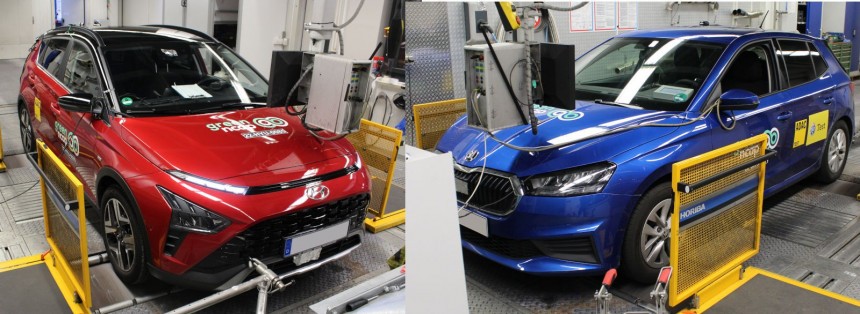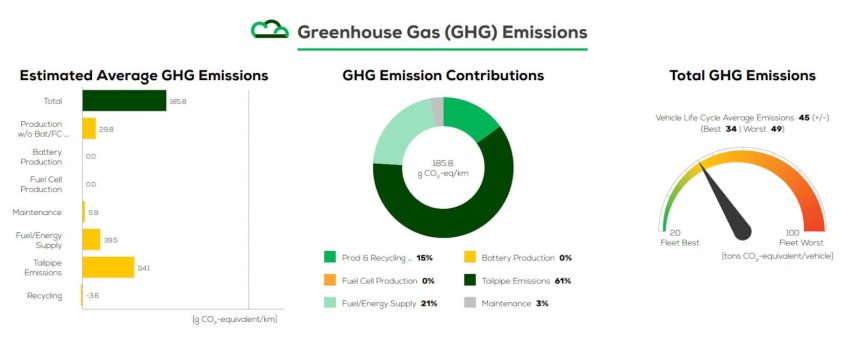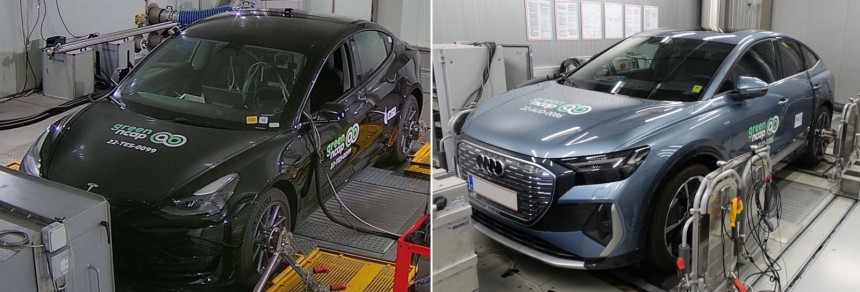“The size does matter” states Green NCAP referring to cars. If the car industry is to continue the SUV trend, with bigger and, most importantly, heavier cars, this will only lead to bigger environmental problems. More greenhouse gas emissions and more primary energy demand for producing and using both ICE and battery-electric vehicles are definitely not a good approach.
The most recent study of Green NCAP should make you think twice before choosing an SUV over a normal passenger car. That is if you care more about the environmental damage you cause than bigger space, more practicality, and that marketing-enticed adventure feeling of an SUV.
In 2022 and 2023, Green NCAP used an updated methodology to test 34 cars with all powertrain types around, from conventional gasoline and diesel or biofuel to hybrid, plug-in hybrid, and electric. They made calculations based on the Life Cycle Assessment tool, which takes into account the average energy mix in the EU and UK, but also an average mileage of 240,000 km (150,000 miles) over 16 years.
The cars tested in 2021 are absent from this new study because now Green NCAP considers the most recent forecasts for 2022-2037 regarding the increasing share of battery production in Europe, and the increase in energy demand and production.
Here is a list of the cars in this study, ranked by their mass, because this is the main topic the study is more concerned about. You can also see the corresponding values for Total Greenhouse Gas Emissions (GGE) and Total Primary Energy Demand (PED).
1. Land Rover Range Rover D350 AWD (diesel) – 2,713 kg (5,980 lbs.) - GGE: 86 tons CO2-eq // PED: 335 MWh
2. NIO ET7 480 kW AWD (electric) – 2,379 kg (5,240 lbs.) - GGE: 35 tons CO2-eq // PED: 193 MWh
3. Audi Q4 e-tron Sportback 50 quattro (electric) – 2,242 kg (4,940 lbs.) - GGE: 36 tons CO2-eq // PED: 204 MWh
4. Genesis GV70 2.5 TGDI AWD (gasoline) – 1,955 kg (4,310 lbs.) - GGE: 83 tons CO2-eq // PED: 334 MWh
5. Lynk & Co 01 192 kW (plug-in hybrid) – 1,879 kg (4,140 lbs.) - GGE: 48 tons CO2-eq // PED: 227 MWh
6. Hyundai IONIQ 5 58 kWh (electric) – 1,845 kg (4,070 lbs.) - GGE: 32 tons CO2-eq // PED: 186 MWh
7. Cupra Born 170 kW e-Boost (electric) – 1,827 kg (4,030 lbs.) - GGE: 30 tons CO2-eq // PED: 177 MWh
8. Genesis G70 Shooting Brake 2.2 (diesel) – 1,788 kg (3,940 lbs.) - GGE: 67 tons CO2-eq // PED: 261 MWh
9. Tesla Model 3 208 kW (electric) – 1,760 kg (3,880 lbs.) - GGE: 28 tons CO2-eq // PED: 158 MWh
10. Kia Sportage 1.6 T-GDi 48V AWD (gasoline) – 1,687 kg (3,720 lbs.) - GGE: 65 tons CO2-eq // PED: 262 MWh
11. Renault Megane E-Tech EV60 160 kW (electric) – 1,684 kg (3,710 lbs.) - GGE: 28 tons CO2-eq // PED: 167 MWh
12. Subaru Outback 2.5i Lineartronic (gasoline) – 1,674 kg (3,690 lbs.) - GGE: 72 tons CO2-eq // PED: 291 MWh
13. Hyundai Tucson HEV 1.6 T-GDI (hybrid) – 1,642 kg (3,620 lbs.) - GGE: 58 tons CO2-eq // PED: 232 MWh
14. Mercedes-Benz T-Class T180 (gasoline) – 1,580 kg (3,480 lbs.) - GGE: 64 tons CO2-eq // PED: 256 MWh
15. VW Caddy 1.5 TSI (gasoline) – 1,567 kg (3,450 lbs.) - GGE: 58 tons CO2-eq // PED: 234 MWh
16. BMW 220i Active Tourer (gasoline) – mass: 1,543 kg (3,400 lbs.) - GGE: 54 tons CO2-eq // PED: 217 MWh
17. Renault Kangoo TCe 130 (gasoline) – 1,536 kg (3,390 lbs.) - GGE: 63 tons CO2-eq // PED: 254 MWh
18. VW Touran 1.5 TSI OPF (gasoline) – 1,510 kg (3,330 lbs.) - GGE: 60 tons CO2-eq // PED: 242 MWh
19. Nissan Qashqai 1.3 DIG-T Mild Hybrid (gasoline) – 1,441 kg (3,180 lbs.) - GGE: 59 tons CO2-eq // PED: 239 MWh
20. DS4 Puretech 225 (gasoline) – 1,438 kg (3,170 lbs.) - GGE: 62 tons CO2-eq // PED: 242 MWh
21. Honda HR-V 1.5 i-MMD (hybrid) – 1,390 kg (3,060 lbs.) - GGE: 53 tons CO2-eq // PED: 215 MWh
22. Ford Focus 1.0 EcoBoost Mild Hybrid (gasoline) – 1,355 kg (2,990 lbs.) - GGE: 51 tons CO2-eq // PED: 205 MWh
23. Peugeot 308 1.2 PureTech 130 (gasoline) – 1,323 kg (2,920 lbs.) - GGE: 54 tons CO2-eq // PED: 218 MWh
24. Opel Mokka 1.5 (diesel) – 1,253 kg (2,762 lbs.) - GGE: 45 tons CO2-eq // PED: 179 MWh
25. Ford Puma 1.0 EcoBoost Flexifuel (gasoline) – 1,244 kg (2,750 lbs.) - GGE: 51 tons CO2-eq // PED: 206 MWh
26. Ford Puma 1.0 EcoBoost Flexifuel (ethanol E85) – 1,244 kg (2,750 lbs.) - GGE: 38 tons CO2-eq // PED: 322 MWh
27. Toyota Yaris Cross 1.5 (hybrid) – 1,241 kg (2,730 lbs.) - GGE: 50 tons CO2-eq // PED: 201 MWh
28. Hyundai Bayon 1.0 T-GDI 48V (gasoline) – 1,194 kg (2,630 lbs.) - GGE: 50 tons CO2-eq // PED: 200 MWh
29. SEAT Ibiza 1.0 TSI 81 kW (gasoline) – 1,153 kg (2,540 lbs.) - GGE: 51 tons CO2-eq // PED: 204 MWh
30. Skoda Fabia 1.0 MPI (gasoline) – 1,069 kg (2,350 lbs.) - GGE: 45 tons CO2-eq // PED: 180 MWh
31. Fiat 500 Hybrid 1.0 GSE (gasoline) – 1,029 kg (2,270 lbs.) - GGE: 43 tons CO2-eq // PED: 172 MWh
32. KIA Picanto (gasoline) – 1,019 kg (2,250 lbs.) - GGE: 46 tons CO2-eq // PED: 187 MWh
33. Toyota Aygo X 53 kW (gasoline) – 981 kg (2,160 lbs.) - GGE: 45 tons CO2-eq // PED: 179 MWh
34. Dacia Spring 33 kW (electric) – 970 kg (2,140 lbs.) - GGE: 21 tons CO2-eq // PED: 134 MWh
There’s not too much basis for comparison, as most cars are too different in class and powertrains. For now, you should consider these cars as benchmarks relative to their competition. A similar car in size and powertrain will have similar results regarding lifecycle emissions and primary energy demand.
When we compare GHG emissions for the entire lifecycle of the cars, the difference is five tons in favor of Fabia. Therefore, Fabia is 10% less CO2-eq emitting than Bayon. The same percentage is valid for energy demand. So, in this comparison, the 10% less heavy car is 10% less harmful.
We’ll get similar results, only slightly higher when comparing the gasoline Fabia and the gasoline Ford Puma, which has almost similar mass as Bayon. Interestingly, the gasoline Seat Ibiza, which is the sibling of Fabia, is heavier than its Czech cousin because of the powertrain. The story is the same: the heavier Ibiza has worse values than Fabia in terms of emissions and energy demand.
But there’s another part of the story. As we all know, consumption in real life is higher than official homologated values. Green NCAP tests also offer best-case scenario values and worst-case scenario values for emissions and energy demand.
In the worst-case scenario, Fabia’s emissions are 49 tons, and Ibiza’s 56. While Bayon’s emissions are 61 tons, and gasoline Puma’s 59. The SUVs get worse emissions values than city cars and the difference between Fabia and Bayon, both gasoline cars, increases from 10% to 20%.
How about comparing the gasoline city car Fabia to a small diesl SUV, like the Opel Mokka? The latter is 184 kg (405 lbs.) heavier, but emissions and energy demand are the same amounts. That’s because diesel engines are less CO2 emitting than gasoline engines, so it offsets the 15% higher mass of the small diesel SUV.
But then in the worst-case scenario, the heavier small diesel SUV loses ground and becomes 16% more emitting. In fact, in the worst-case scenario, the diesel SUV is very close to the gasoline SUV in terms of emissions, which is also true in the best-case scenario. By the way, in this scenario, Fabia is 20% less emitting than the gasoline SUV and 12% less than the diesel SUV.
We’re not done yet. If we compare the gasoline Fabia with the methanol E85 Ford Puma small SUV, the 14% lighter car has 15% more emissions. That’s because biofuel is much less CO2 emitting than gasoline. In return, the E85 Puma has 45% higher energy demand, because sourcing biofuel is very energy intensive.
How about comparing the gasoline city car to a hybrid small SUV, like Toyota Yaris Cross? Which is based on Fabia’s direct competitor Yaris. Fabia is 14% lighter, 10% less emitting, and 10% less energy demanding. Just like the gasoline Bayon, only the hybrid SUV is heavier than the gasoline SUV.
It's unexpected, but in the worst-case scenario, the hybrid SUV fares worse than the gasoline SUV and the diesel SUV and is way much more emitter than the biofuel SUV. Of course, the situation could be different from other models. But I think that’s enough for now for making the point that heavier cars, especially SUVs, have 10% to 20% more emissions on average than passenger cars.
We could also compare two models from Stellantis Group, but in our case, the SUV-ish DS4 has a more powerful gasoline engine than the compact car Peugeot 308. And its more-than-one-liter-higher consumption makes the 308 the clear winner in terms of efficiency.
A more appropriate comparison is to put face to face the 308 and the compact van Renault Kangoo because they are very similar in terms of powertrains (both ga turbo). Also, Kangoo’s mass and dimensions are close to a compact SUV, so it fits the topic.
Peugeot 308 is 14% lighter than Kangoo, and the same percentage applies to lower emissions and energy demand. Interestingly, in the worst-case scenario, 308 is 11% less emitter than Kangoo, so the compact van gains some credit. Nevertheless, the heavier car fares worse.
But we can compare the sedan Tesla Model 3 and the SUV Audi Q4, as they have similar performances. Model 3 is 21% lighter than Q4, and its emissions are 22% lower, and so is the energy demand. In the worst-case scenario, Audi reduces the percentage to 14%, but you already know this comparison fits the story.
Basically, comparing cars and SUVs with similar powertrains and performances results in heavier cars having more emissions and energy demand by an average of 10-15%. Or even more in a worst-case scenario, which can be attributed to in-city driving.
While such a difference doesn’t seem terrible, in the bigger picture millions of SUVs are responsible for millions more tons of emissions in the air and millions more MWh of energy demand. Any powertrain improvement in cars is canceled by heavier SUVs.
Oh, and let’s not forget that, in the case of EVs, bigger batteries for longer ranges mean higher mass, which affects the range. So, SUVs just contribute to a spiral of inefficiency, both in the ICE realm and in batteries. And future tests from Green NCAP will probably make it clearer.
I know this isn’t going to be a popular idea, but maybe a tax on a car’s weight is the right thing to do. It’s just one of the tools to discourage both carmakers and customers to continue favoring heavier SUVs over normal cars. The SUV trend is the elephant in the room for the auto industry, but first, we all have to acknowledge this uncomfortable truth.
In 2022 and 2023, Green NCAP used an updated methodology to test 34 cars with all powertrain types around, from conventional gasoline and diesel or biofuel to hybrid, plug-in hybrid, and electric. They made calculations based on the Life Cycle Assessment tool, which takes into account the average energy mix in the EU and UK, but also an average mileage of 240,000 km (150,000 miles) over 16 years.
The cars tested in 2021 are absent from this new study because now Green NCAP considers the most recent forecasts for 2022-2037 regarding the increasing share of battery production in Europe, and the increase in energy demand and production.
Here is a list of the cars in this study, ranked by their mass, because this is the main topic the study is more concerned about. You can also see the corresponding values for Total Greenhouse Gas Emissions (GGE) and Total Primary Energy Demand (PED).
1. Land Rover Range Rover D350 AWD (diesel) – 2,713 kg (5,980 lbs.) - GGE: 86 tons CO2-eq // PED: 335 MWh
2. NIO ET7 480 kW AWD (electric) – 2,379 kg (5,240 lbs.) - GGE: 35 tons CO2-eq // PED: 193 MWh
3. Audi Q4 e-tron Sportback 50 quattro (electric) – 2,242 kg (4,940 lbs.) - GGE: 36 tons CO2-eq // PED: 204 MWh
4. Genesis GV70 2.5 TGDI AWD (gasoline) – 1,955 kg (4,310 lbs.) - GGE: 83 tons CO2-eq // PED: 334 MWh
5. Lynk & Co 01 192 kW (plug-in hybrid) – 1,879 kg (4,140 lbs.) - GGE: 48 tons CO2-eq // PED: 227 MWh
6. Hyundai IONIQ 5 58 kWh (electric) – 1,845 kg (4,070 lbs.) - GGE: 32 tons CO2-eq // PED: 186 MWh
7. Cupra Born 170 kW e-Boost (electric) – 1,827 kg (4,030 lbs.) - GGE: 30 tons CO2-eq // PED: 177 MWh
8. Genesis G70 Shooting Brake 2.2 (diesel) – 1,788 kg (3,940 lbs.) - GGE: 67 tons CO2-eq // PED: 261 MWh
9. Tesla Model 3 208 kW (electric) – 1,760 kg (3,880 lbs.) - GGE: 28 tons CO2-eq // PED: 158 MWh
10. Kia Sportage 1.6 T-GDi 48V AWD (gasoline) – 1,687 kg (3,720 lbs.) - GGE: 65 tons CO2-eq // PED: 262 MWh
11. Renault Megane E-Tech EV60 160 kW (electric) – 1,684 kg (3,710 lbs.) - GGE: 28 tons CO2-eq // PED: 167 MWh
12. Subaru Outback 2.5i Lineartronic (gasoline) – 1,674 kg (3,690 lbs.) - GGE: 72 tons CO2-eq // PED: 291 MWh
13. Hyundai Tucson HEV 1.6 T-GDI (hybrid) – 1,642 kg (3,620 lbs.) - GGE: 58 tons CO2-eq // PED: 232 MWh
14. Mercedes-Benz T-Class T180 (gasoline) – 1,580 kg (3,480 lbs.) - GGE: 64 tons CO2-eq // PED: 256 MWh
15. VW Caddy 1.5 TSI (gasoline) – 1,567 kg (3,450 lbs.) - GGE: 58 tons CO2-eq // PED: 234 MWh
16. BMW 220i Active Tourer (gasoline) – mass: 1,543 kg (3,400 lbs.) - GGE: 54 tons CO2-eq // PED: 217 MWh
17. Renault Kangoo TCe 130 (gasoline) – 1,536 kg (3,390 lbs.) - GGE: 63 tons CO2-eq // PED: 254 MWh
18. VW Touran 1.5 TSI OPF (gasoline) – 1,510 kg (3,330 lbs.) - GGE: 60 tons CO2-eq // PED: 242 MWh
19. Nissan Qashqai 1.3 DIG-T Mild Hybrid (gasoline) – 1,441 kg (3,180 lbs.) - GGE: 59 tons CO2-eq // PED: 239 MWh
20. DS4 Puretech 225 (gasoline) – 1,438 kg (3,170 lbs.) - GGE: 62 tons CO2-eq // PED: 242 MWh
21. Honda HR-V 1.5 i-MMD (hybrid) – 1,390 kg (3,060 lbs.) - GGE: 53 tons CO2-eq // PED: 215 MWh
22. Ford Focus 1.0 EcoBoost Mild Hybrid (gasoline) – 1,355 kg (2,990 lbs.) - GGE: 51 tons CO2-eq // PED: 205 MWh
23. Peugeot 308 1.2 PureTech 130 (gasoline) – 1,323 kg (2,920 lbs.) - GGE: 54 tons CO2-eq // PED: 218 MWh
24. Opel Mokka 1.5 (diesel) – 1,253 kg (2,762 lbs.) - GGE: 45 tons CO2-eq // PED: 179 MWh
25. Ford Puma 1.0 EcoBoost Flexifuel (gasoline) – 1,244 kg (2,750 lbs.) - GGE: 51 tons CO2-eq // PED: 206 MWh
26. Ford Puma 1.0 EcoBoost Flexifuel (ethanol E85) – 1,244 kg (2,750 lbs.) - GGE: 38 tons CO2-eq // PED: 322 MWh
27. Toyota Yaris Cross 1.5 (hybrid) – 1,241 kg (2,730 lbs.) - GGE: 50 tons CO2-eq // PED: 201 MWh
28. Hyundai Bayon 1.0 T-GDI 48V (gasoline) – 1,194 kg (2,630 lbs.) - GGE: 50 tons CO2-eq // PED: 200 MWh
29. SEAT Ibiza 1.0 TSI 81 kW (gasoline) – 1,153 kg (2,540 lbs.) - GGE: 51 tons CO2-eq // PED: 204 MWh
30. Skoda Fabia 1.0 MPI (gasoline) – 1,069 kg (2,350 lbs.) - GGE: 45 tons CO2-eq // PED: 180 MWh
31. Fiat 500 Hybrid 1.0 GSE (gasoline) – 1,029 kg (2,270 lbs.) - GGE: 43 tons CO2-eq // PED: 172 MWh
32. KIA Picanto (gasoline) – 1,019 kg (2,250 lbs.) - GGE: 46 tons CO2-eq // PED: 187 MWh
33. Toyota Aygo X 53 kW (gasoline) – 981 kg (2,160 lbs.) - GGE: 45 tons CO2-eq // PED: 179 MWh
34. Dacia Spring 33 kW (electric) – 970 kg (2,140 lbs.) - GGE: 21 tons CO2-eq // PED: 134 MWh
There’s not too much basis for comparison, as most cars are too different in class and powertrains. For now, you should consider these cars as benchmarks relative to their competition. A similar car in size and powertrain will have similar results regarding lifecycle emissions and primary energy demand.
City cars vs small SUVs
For this example, I will compare Skoda Fabia and Hyundai Bayon. The latter is a small crossover based on its sibling Hyundai i20, which is a direct competitor to Skoda Fabia. Both Fabia and Bayon are gasoline cars, yet the difference in mass is 125 kg (275 lbs.) in favor of the city car. Therefore, Fabia is 10% lighter.We’ll get similar results, only slightly higher when comparing the gasoline Fabia and the gasoline Ford Puma, which has almost similar mass as Bayon. Interestingly, the gasoline Seat Ibiza, which is the sibling of Fabia, is heavier than its Czech cousin because of the powertrain. The story is the same: the heavier Ibiza has worse values than Fabia in terms of emissions and energy demand.
But there’s another part of the story. As we all know, consumption in real life is higher than official homologated values. Green NCAP tests also offer best-case scenario values and worst-case scenario values for emissions and energy demand.
In the worst-case scenario, Fabia’s emissions are 49 tons, and Ibiza’s 56. While Bayon’s emissions are 61 tons, and gasoline Puma’s 59. The SUVs get worse emissions values than city cars and the difference between Fabia and Bayon, both gasoline cars, increases from 10% to 20%.
How about comparing the gasoline city car Fabia to a small diesl SUV, like the Opel Mokka? The latter is 184 kg (405 lbs.) heavier, but emissions and energy demand are the same amounts. That’s because diesel engines are less CO2 emitting than gasoline engines, so it offsets the 15% higher mass of the small diesel SUV.
But then in the worst-case scenario, the heavier small diesel SUV loses ground and becomes 16% more emitting. In fact, in the worst-case scenario, the diesel SUV is very close to the gasoline SUV in terms of emissions, which is also true in the best-case scenario. By the way, in this scenario, Fabia is 20% less emitting than the gasoline SUV and 12% less than the diesel SUV.
How about comparing the gasoline city car to a hybrid small SUV, like Toyota Yaris Cross? Which is based on Fabia’s direct competitor Yaris. Fabia is 14% lighter, 10% less emitting, and 10% less energy demanding. Just like the gasoline Bayon, only the hybrid SUV is heavier than the gasoline SUV.
It's unexpected, but in the worst-case scenario, the hybrid SUV fares worse than the gasoline SUV and the diesel SUV and is way much more emitter than the biofuel SUV. Of course, the situation could be different from other models. But I think that’s enough for now for making the point that heavier cars, especially SUVs, have 10% to 20% more emissions on average than passenger cars.
Compact cars vs. compact SUVs
Let’s take for this example the gasoline mild-hybrids Ford Focus and Nissan Qashqai. The difference in mass is a relatively low 86 kg (190 lbs.), which is 6%. But the difference in emissions is 13% and in energy demand is 14%. In the worst-case scenario, the difference in emissions increases to 17%.A more appropriate comparison is to put face to face the 308 and the compact van Renault Kangoo because they are very similar in terms of powertrains (both ga turbo). Also, Kangoo’s mass and dimensions are close to a compact SUV, so it fits the topic.
Peugeot 308 is 14% lighter than Kangoo, and the same percentage applies to lower emissions and energy demand. Interestingly, in the worst-case scenario, 308 is 11% less emitter than Kangoo, so the compact van gains some credit. Nevertheless, the heavier car fares worse.
What about heavy electric cars?
Batteries make electric cars heavier than their ICE or electrified rivals, that’s for sure. For instance, Renault Megane E-Tech EV60 is more compact than the DS4, but, having similar performances, the electric French car is 14% heavier than the petrol French car. Of course, the ICE car’s emissions are twice as much and its energy demand is much higher.But we can compare the sedan Tesla Model 3 and the SUV Audi Q4, as they have similar performances. Model 3 is 21% lighter than Q4, and its emissions are 22% lower, and so is the energy demand. In the worst-case scenario, Audi reduces the percentage to 14%, but you already know this comparison fits the story.
While such a difference doesn’t seem terrible, in the bigger picture millions of SUVs are responsible for millions more tons of emissions in the air and millions more MWh of energy demand. Any powertrain improvement in cars is canceled by heavier SUVs.
Oh, and let’s not forget that, in the case of EVs, bigger batteries for longer ranges mean higher mass, which affects the range. So, SUVs just contribute to a spiral of inefficiency, both in the ICE realm and in batteries. And future tests from Green NCAP will probably make it clearer.
I know this isn’t going to be a popular idea, but maybe a tax on a car’s weight is the right thing to do. It’s just one of the tools to discourage both carmakers and customers to continue favoring heavier SUVs over normal cars. The SUV trend is the elephant in the room for the auto industry, but first, we all have to acknowledge this uncomfortable truth.







